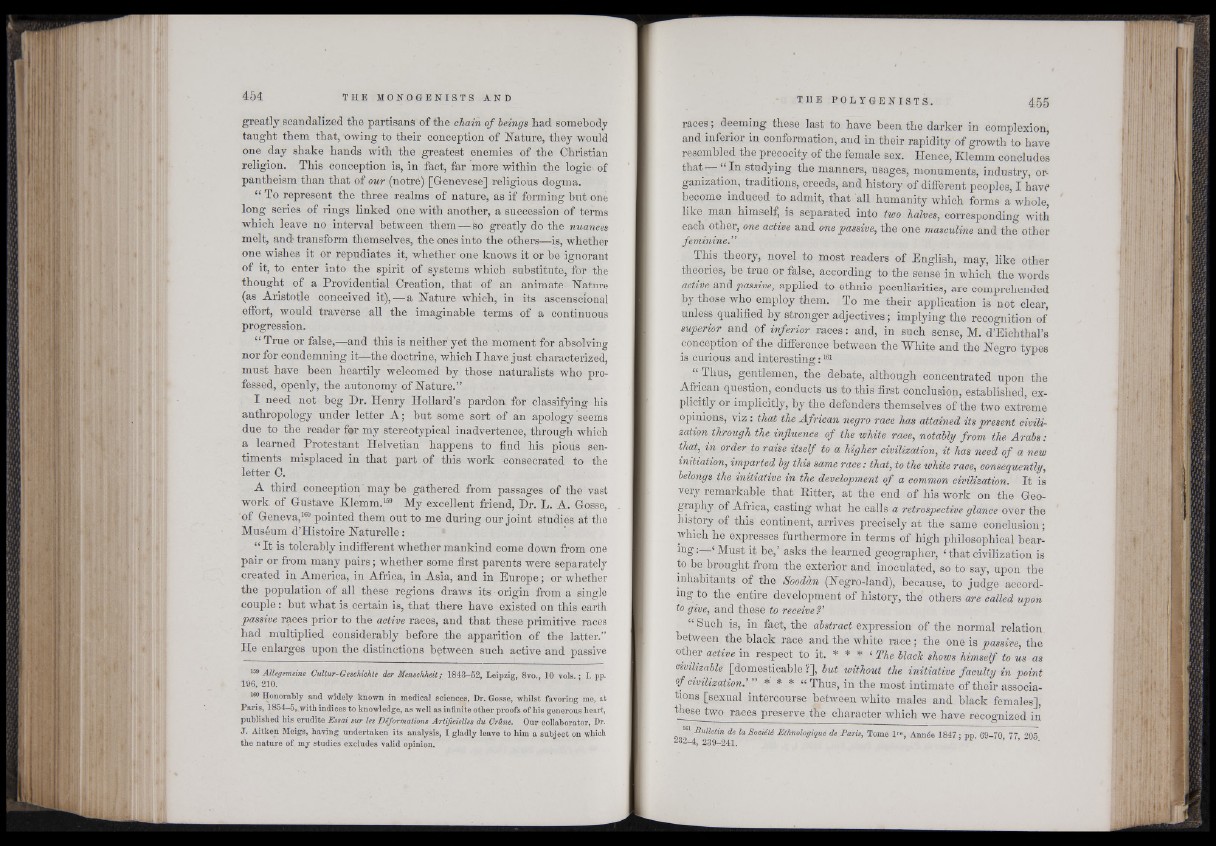
greatly scandalized tlie partisans of the chain of beings had somebody
taught them that, 'owing to their conception of Nature, they would
one day shake hands with the greatest enemies of the Christian
religion. This conception is, in fact, far more within the logic of
pantheism than that of our (notrô) [G-enevese] religious dogma.
“ To represent the three realms of nature, as if forming but one
long series of rings linked one with another, a succession of terms
which leave no interval between them — so greatly do the nuances
melt, and' transform themselves, the ones into the others—is, whether
one wishes it or repudiates it, whether one knows it or he ignorant
of it, to enter into the spirit of systems which substitute, for the
thought of a Providential Creation, that of an animate Nature
(as Aristotle conceived it),—a Nature which, in its ascenscional
effort, would traverse all the imaginable terms of a continuous
progression.
§ True or false,—and this is neitheryet the moment for absolving
nor for condemning it—the doctrine, which I have just characterized,
must have been heartily welcomed by those naturalists who professed,
openly, the autonomy of Nature.”
I need not beg Dr. Henry Hollard’s pardon, for classifying his
anthropology under letter A; hut some sort of an apology seems
due to the reader far my stereotypical inadvertence, through which
a learned Protestant Helvetian happens to find his pious sentiments
misplaced in that part of this work consecrated to the
letter C.
A third conception may he gathered from passages of the vast
work, of Gustave Klemm.159 My excellent friend, Dr. L. A. Gosse,
of Geneva,160 pointed them out to me during our joint studies at the
Muséum d’Histoire Naturelle :
“ It is tolerably indifferent whether mankind come down from one
pair or from many pairs ; whether some first parents were separately
created in America, in Africa, in Asia, and in Europe ; or whether
the population of all these regions draws its origin from a single
couple : but what is certain is, that there have existed on this earth
passive races prior to the active races, and that these primitive races
had multiplied considerably before the apparition of the latter.”
He enlarges upon the distinctions between such active and passive
159 Allegemeine Cultur-Geschiohte der Menschheit; 1843-52, Leipzig, 8vo., 10 vols. ; I. pp.
196, 210.
160 Honorably and widely known in medical sciences, Dr. Gosse, whilst favoring me, at
Paris, 1854-5, with indices to knowledge, as well as infinite other proofs of his generous heart,
published his erudite Essai sur les Déformations Artificielles du Crâne. Our collaborator, Dr.
J. Aitken Meigs, having undertaken its analysis, I gladly leave to him a subject on which
the nature of my studies excludes valid opinion.
races; deeming these last to have been the darker in complexion,
and inferior in conformation, and in their rapidity of growth to have
resembled the precocity of the female sex. Hence, Klemm concludes
that “ In studying the manners, usages, monuments, industry, organization,
traditions, creeds, and history of different peoples, I have*
become induced to admit, that all humanity which forms a whole,
like man himself, is separated into two halves, corresponding with
each other, one active and one passive, the one masculine and the other
feminine.”
This theory, novel to most readers of English, may, like other
theories, be true or false, according to the sense in which the words
active and passive, applied to ethnic peculiarities, are comprehended
by those who employ them. To me their application is not clear,
unless qualified by stronger adjectives; implying the recognition of
superior' and of inferior races: and, in such sense, M. d’Eichthal’s
conception of the difference between the White and the Negro types
is curious and interesting:161
“ Thus, gentlemen, the debate, although concentrated upon the
African question, conducts us to this first conclusion, established, explicitly
or implicitly, by the defenders themselves of the two extreme
opinions, v iz : that the African negro race has attained its present civilization
through the influence of the white race, notably from the Arabs:
that, in order to raise itself to a higher civilization, it has need of a new
initiation, imparted by this same race: that, to the white race, consequently,
belongs the initiative in the development of a common civilization. It is
very remarkable that Ritter, at the end of his work on the Geography
of Africa, easting what he calls a retrospective glance over the
history of this continent, arrives precisely at the same conclusion;
which he expresses furthermore in terms of high philosophical bear-
ing: ‘ Must it be, asks the learned geographer, ‘ that civilization is
to be brought from the exterior and inoculated, so to say, upon the
inhabitants of the Soodhn (Negro-land), because, to judge according
to the entire development of history, the others are called upon
to give, and these to receive?’
“ Such is, in fact, the abstract expression of the normal relation
between the black race and the white race; the one is passive, the
other active in respect to it. * * * ‘ The black shows himself to L as
eivilizable [domesticable ?], but without the initiative faculty in point
of civilization: ” *' * * “ Thus, in the most intimate of their associations
[sexual intercourse between white males and black females],
these two races preserve the character which we have recognized in
61 Bulletin de la Société Ethnologique de Paris, Tome l « . Année 1847: pp 69-70 77 205
232-4, 289-241. ’ ’